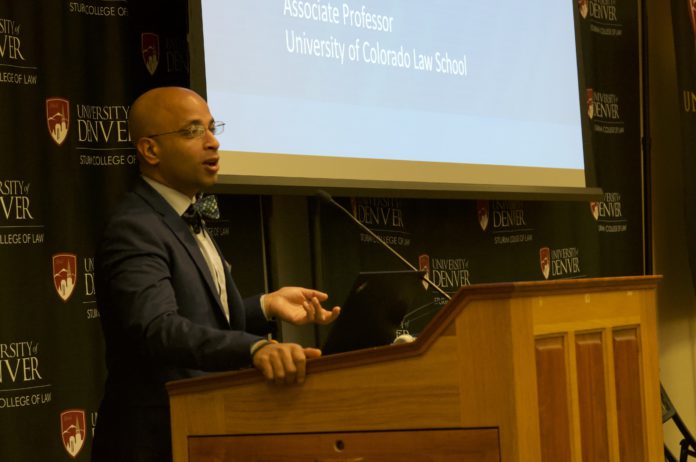

Gabe Roth thinks video cameras could fix the U.S. Supreme Court.
At least, that’s one of the prescriptions the founder and executive director of the non-partisan advocacy group Fix the Court offered Oct. 26 during his talk, “Modernizing the Federal Judiciary, One Court at a Time,” at the 2019 American Constitution Society Western Regional Convening at the University of Denver Sturm College of Law.
Given his journalistic background, it’s not surprising that improved media access tops the list of changes Roth, a former TV news producer, has advocated though the New York-based organization dedicated to increasing transparency and accountability in the federal courts and the U.S. Supreme Court in particular.
Roth said the U.S. Supreme Court lags behind other federal and state courts in terms of video and audio access. The U.S. Supreme Court doesn’t allow cameras at all and, while it does record audio, the court’s same-day transcripts are “riddled with errors,” he said, and the actual recordings are not released until the end of the week. For cases argued on Mondays or Tuesdays, that’s “20 different news cycles” too late, Roth said.
He said critics of the idea often argue C-SPAN’s coverage of Congress has led to lawmakers grandstanding and playing to the cameras, with little debate on the floor. But Roth said this is an apples-to-oranges comparison.
“To my knowledge, no one on the Supreme Court is going to be running for Senate or president and [they don’t] need to say a cute little one-liner that gets them airtime,” he said.
He said many state supreme courts, including Colorado’s, and federal appellate courts across the country allow live video of court proceedings without any negative consequences. If anything, he said, the cameras have made these judges “kinder to lawyers” and “more lenient on time.”
The U.S. Supreme Court has allowed same-day audio 27 times for big cases, in part due to requests and lobbying by Fix the Court. The court even livestreamed video of the bar memorial for Justice Antonin Scalia in 2016. “So, they have the ability to do it, they just don’t want to do it,” Roth said.
In addition to increasing transparency and access to one of the most powerful institutions in government, live broadcasts and streaming of oral arguments could serve as an educational tool for law students and the general public, according to Roth. He said broadcasters could display explanations for legal jargon on screen in real time so viewers can follow along, like a SCOTUS version of VH1’s “Pop-Up Video.”
Cameras aren’t the only change Roth suggested for increasing transparency. He said his group also wants Supreme Court justices to publicize their reasons for recusal and file their financial disclosures online.
According to the group’s website, Fix the Courts publishes reports about why justices might have recused themselves on certain cases. The organization has also successfully lobbied to make financial disclosures available by thumb drive, the site says, but these digital versions are not searchable or machine-readable and justices are not required to disclose as much detail as officials in other branches of government.
Roth said his calls for more transparency in the courts have bipartisan support. Earlier this year, lawmakers from both parties introduced legislation in the House and Senate to make PACER free. Roth said he was able to convince Republican Sen. Ted Cruz and Democratic Sen. Mazie Hirono, two co-sponsors of the Senate version of the PACER bill, to sign letters to request same-day audio for the “travel ban” case Trump v. Hawaii in April 2018, the last time such a request was granted.
Aside from increased transparency, the other major change Fix the Courts wants to see is an end to lifetime appointments, a practice that began, in Roth’s telling, as a result of political machinations in 17th century England and that the U.S. inherited from its British forebears.
“Every modern democracy that has established a court of last resort in the last hundred years … has either had retention elections, term limits or a mandatory retirement age,” Roth said.
He said he’s working on a bill that would keep lifetime tenure for Supreme Court justices but require justices to rotate off the bench after 18 years, at which point they would become senior justices who could fill in if a sitting justice dies or a judicial nomination is held up in Congress.
As long as lifetime appointments remain in place, Roth said there are a few things courts could do to mitigate the effects of an aging federal judiciary and cognitive decline among judges.
He said he’s working with circuit courts to adopt judicial wellness programs modeled on a similar initiative from the Ninth Circuit.
The programs include a hotline judges can call if they notice they are forgetting things or having health problems and a “buddy system” for judges to check in with each other about their health and fitness for the job.
Roth said Fix the Courts has also tried to address the selection process for judges by asking senators to create a judicial nominating commission, but the organization hasn’t had much luck in those efforts. “It’s just been a big failure, to be perfectly honest,” he said.
— Jessica Folker, [email protected]

